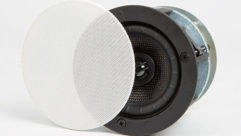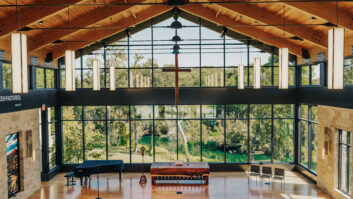Higher rewards
Jan 1, 1999 12:00 PM,
Drew Daniels
Although not as lucrative as some other jobs, I derive satisfaction fromhelping smaller churches. Larger sound firms do not usually like tiny jobs.In some cases, the formidable bidding processes are so intimidating thatthe organization falls back on amateur help or gives up trying to improveits sound at all. I have witnessed this scenario several times.
Before I cover small church jobs, however, let me point out that you shouldnever make changes that do not provide substantial benefits. This statementapplies to almost any sound job. Your credibility as a contractor orconsultant is always enhanced by honesty, even if it means you do no workat all for the client. Among top pros in the acoustical consultingbusiness, there are many stories of heroic self-control in the face oftempting profits. A friend once told me of a consultation with NASA inwhich he was hired to assess the viability of a potentially lucrative voicewarning system in the Vertical Assembly Building at Cape Canaveral. Aftermeasuring the acoustics in the building, he told NASA that a voice systemwas impractical and advised no changes to the existing klaxon system.Installing a new sound system would have produced a non-functional,high-cost boondoggle that may have destroyed his firm’s credibility.
Getting the jobAn axiom in the church sound business holds that a typical church has threesound systems during its existence. The first is put in by the parishionerwith the best stereo. The second is put in by the parishioner’s musicianson using black-painted rock-P.A. loudspeaker boxes from the local musicstore. The last is installed by an audio professional. In too many cases,however, there is a fourth system or even an ongoing trial-and-error streamof inappropriate equipment cycling though the building, and thecongregation never actually comes in contact with a real audioprofessional. Unfortunately, it is not unusual that an inferior audioconsultant turns out to be a good salesman who can keep the work comingwithout ever getting it right.
Networking is the best way to make contacts with people in need of yourservices, and personal contact is critical. A friend who attends manydifferent church services throughout the year has referred people fordesign assistance. These contacts have provided more contacts, and so itgoes. Church clients generally prefer to meet service providers who havebeen personally recommended by trusted friends and colleagues. This is notto say that you would fail to get the occasional call from an ad response,but that can be a waste of resources in this particular business area.
Written contracts are virtually never used. The preferred businessarrangement is a handshake agreement with complete disclosure of costs upfront. Include all possible cost options, even such unexpected costs andincidentals as the wireless mic requested after the bid spreadsheet iscompleted. Be thorough and careful when you estimate, and build in somemargin or profit that you can sacrifice if things go bad during theinstallation. On the other hand, it is still best to minimize costs everyway possible, which may require some creativity. I often work with WesDooley on behalf of his firm, Audio Engineering Associates, Pasadena, CA,using an engineer subcontractor for installs. At other times, I providedrawings and equipment lists to clients who have engineers in thecongregation. The desired result is usually a low-cost, high-performancesound system, which is not necessarily a mutually exclusive pair of systemcriteria.
There are pitfalls. Whenever a church board requires a bid, the cost of thesound system triples or quadruples. Whenever I have to spell out a contracton paper, the small church client gets cold feet. I will not providedrawings or designs to a client unless the client either pays up front orsigns a non-disclosure statement, which assures me that the church will notuse my plans or designs for any other purpose that excludes me as theprovider of services. Asking for this kind of non-disclosure assurance canpotentially sour any existing personal trust, so I prefer to keep the plansto myself, do the work on a handshake and keep the cost low.
The purposeJust as it is a recording engineer’s job to help the artist communicateartistic intent to the listener, so it is the job of a sound systemdesigner to design in order to allow the conveyance of the spoken word in aservice. A minister’s speech should be considered an artistic presentationno less than that of a poet, an actor or the music services included inmany religious ceremonies. An audio engineer creating a sound system for asmall church understands the client’s goals even when the expressed goalsdo not coincide with a normal technical rhetoric.
Modern churches have evolved as reflected by the equipment appropriate totoday’s services. More gain is needed for orators with less training invocal projection. More gain, in turn, means mics with better pickuppatterns-supercardioid or hypercardioid rather than the barely cardioidmics of old. Loudspeakers, too, have improved. Technologies such as TEF orMLSSA not only allow laboratories to obtain detailed data on audiotransducer products, but they also allow the assessment of the results ofinstalling those products in the field. Remember, the goal is to cover theaudience with sound while at the same time keeping as much of that sound aspossible off reflecting walls and other surfaces.
In small churches, there are some distinctions to be considered. A churchmay be newer or older, and its equipment may also be ancient or modern. Inchurches with old equipment, the answer to existing sound problems oftenlies in replacing all the old technology with newer technology moreappropriate to the task at hand and the style of presentation. It ispossible, however, something on the existing list of equipment in an oldchurch may be adequate for inclusion in the new sound system. On yourbudget spreadsheet, these items can prove to be big cost savings. Amps aremost often reusable. Sometimes an old vacuum-tube amp can be recycled tomake a suitable driver for narthex loudspeakers, dayroom overflowloudspeakers or even choir fold-back. Mics can also sometimes be recycledfor less critical applications. Every line on the spreadsheet that can beadded with a zero in the cost column either holds system cost down orallows allocation of part of a small, fixed budget for something moreimportant.
There is usually more recyclable gear in newer churches. Look forloudspeakers that have been inappropriately applied and might be reusedmore appropriately. For example, a cluster of two or three black-paintedP.A. cabinets hung in a sanctuary may provide coverage in a choir practiceroom, a bride’s room and maybe a monitor for a remote sound booth. Thereare few black-box systems that have the right horn, compression driver andwoofer characteristics for good speech intelligibility in a church witheven low reverberation. A proper speech loudspeaker system is quitespecific and should be matched as closely as possible to the room.
Gear on a budgetAfter assessing a given church’s existing equipment, make a list and ahand-sketched block diagram. Remember that you are not working fromdrawings as you would for a 3000-seat church. Later, you can do a simplecopy of your sketch in CAD for the manual you will leave at the site. Yourlist should include mics, the mixer, effects, crossovers, amps,loudspeakers and cables and connectors for every device. Consider thecables and connection for every specific device separately. With a biggerjob, there is usually a basic budget for connectors and incidentals thatfits a formula for the number of inputs, outputs, breakout points andpatchbays, but with these smaller jobs, every cent counts, and costs add upto absorb small budgets quickly.
Try as hard as you can to avoid unnecessary items in your system. Forexample, EQs are not necessary with the right loudspeaker. A power-flat(equal acoustic output power at all frequencies) loudspeaker will produceresults in reverberant spaces that easily exceed the performance of themost carefully equalized, non power-flat loudspeakers without any EQ. Donot be led astray about loudspeaker directivity either. Some loudspeakermodels are purported to have superior horn performance. Only patterncontrol is important in a horn intended for speech intelligibility. What isneeded is a constant-directivity (C.D.) horn. Distortion does not make awhit of difference in a church because even a 1 inch (25.4 mm) throatcompression driver makes so little distortion at speech levels that it isvirtually inconsequential. Unless you are attempting to cover a floor 200feet (61 m) long (no longer a small-church job), choosing throat distortionover pattern control as the important horn characteristic may be a mistake.
There are loudspeakers that may be used with a single amp channel. Thesehave internal speaker-level crossovers. In all but a few cases, biampingloudspeakers produces better results, but electronic line-level crossoversare needlessly expensive unless you can create your own.
Feedback control devices may not be needed if you can convince the pastorto abandon a lavalier mic in favor of a handheld model or if you replace anold omnidirectional mic with a modern hypercardioid (you may need tocalculate the system gain improvement). Mic education is a more powerfultool than the best feedback suppressor.
Avoid expensive, hi-fi amps or audio receivers. Follow my first rule ofeconomics: False economy is the most expensive kind. What may look likesavings now could turn around and bite you later. Most receivers aredesigned to drive only moderately reactive home hi-fi loudspeakers and canself-destruct when confronted with the long cabling and reactiveloudspeaker loads found in the type of installations required for publicpresentation spaces. Do not overbuy, either. Purchase only enough amps todo the job at the SPL and distance needed based on the loudspeaker’ssensitivity and directivity. Remember that professional loudspeaker gear isfairly efficient. In a church sanctuary as large as 120 feet (37 m) longand 40 feet (12 m) high (loudspeaker-to-listener maximum distance), youshould get by with one loudspeaker and one amp if you can make 90 dB SPLpeaks at the back row without clipping the amp.
Consider this example. A loudspeaker is rated at 98 dB sensitivity for a 1W @ 1 m measurement. A 100 W amp gives 20 dB of voltage gain, producing 118dB from the loudspeaker at 1 m. At 10.4 feet (3.2 m) from the loudspeaker,the level drops to 108 dB, and at 33 feet (10 m), it is 98 dB again. At 105feet (32 m), the level would be 88 dB. So we can see that an amp with avoltage gain of 22 dB or a 160 W amp will give the required 90 dB at 105feet, and extrapolating further, a 210 W amp and a 98 dB loudspeaker at 120feet (36.6 m) will produce the required 90 dB peaks.
Given that a horn of 100degreesx100degrees dispersion-pretty broad coveragefor a church-will have an output sensitivity in the neighborhood of 110 dBat 1 W @ 1 m, it is clear that distortion at 90 dB, even 100 feet (30 m)away, is not an issue. A moderately sized amp of equivalently moderate costshould be adequate to meet the design goal.
Always use one loudspeaker whenever possible. When one loudspeaker or hornwill cover a particular pew area, never use more. The best speechintelligibility comes from a single point source. Additional audiblesources produce additional audible reflections and wave interferences,degrading intelligibility. Two benefits to using one horn: It is cheaper,and it works better.
For music reinforcement systems in churches, I try for stereo. This oftenmeans installing a second system for music output, but even with theadditional expense, the total double-system cost is rarely more than thecost of a complex cluster that can handle both speech and music but cannotdo it in stereo. One installation found the old black boxes pressed intoservice as a stereo music system mounted behind the organ loft grilles.
Run cables as if you were doing a live remote. EMT conduit and plenum cablepulls are expensive and not always necessary. From the point of view ofshielding and RFI, use high-quality, balanced-line gear with goodcommon-mode rejection all along your audio signal path so that noise is not a problem evenwhen the snake cable is laid on top of an indirect lighting cornice. Inideal situations, there will be no extra cost incurred from the need fortrades to pull wire, cut concrete, do carpentry or build anything. Try toget everything installed creatively without disturbing the building or bymaking the least possible impact on the building.
One notable exception to the last statement is always getting a licensedmechanical or structural engineer, preferably from the congregation, toapprove any rigging you have to do to hang anything. You would never hanganything in the air that you personally would not feel comfortable sleepingunder, but even small loudspeakers falling from 10 feet (3 m) can kill, andthe legal liability of unprofessional rigging is so enormous that you donot want anything to do with it. If it costs extra to obtain a legitimaterigging inspection, budget it and explain it to your client. Do not leaveit to providence, divine or otherwise.
Simple rulesMake an appointment, and do a walk-around of the church. Charge at least$200 and plan on being there at least a couple hours. Let the client knowhe needs to have a check for you when you complete the walk-around. Take aflashlight, a quad-ruled pad and colored pens, a tape measure and anultrasonic measure if you have one. Make thorough sketches of the plans andelevations of the rooms in which you will be working. Make careful notes ofobstacles to wiring or aesthetic problems to remind yourself later of costsassociated with these problems.
Do not depend on getting blueprints of the building. Blueprints may not beon file in the older buildings and may be difficult to obtain and late inarriving if you have to order them from civic agencies and wait for copiesfrom microfiche. Besides, older buildings may have been updated byparishioners with few or no concomitant drawings.
Do make a guesstimate for the client after your walk-around. It takesconsiderable skill to be accurate, but you may be able to dash off a verballist of things you might consider and then adjust the costs as you sit downand really dig into the design to refine away unnecessary fat. The skillyou will acquire in doing this will help you in all your future estimatingtasks, large and small. Be sure to comfort clients by letting them know theactual final costs will probably be lower than the guesstimate.
Do not make sweeping condemnations of another soundperson’s existing work.Feel free to use my term “architorture” to describe how the unfortunateparallel walls, balcony face and other architectural elements in thesanctuary degrade sound clarity, but be prepared to explain how things workif you touch upon acoustics. Sound cannot be seen with the eyes and is muchmore difficult to demonstrate than waving a light around.
Be sure to explain to the client how proper application of acousticabsorption, wall, ceiling and other treatments would aid speechintelligibility, ruin choral music acoustics and cost a fortune. You canuse a rough $10/ft2 as an absolute minimum figure of merit to show how muchit might cost (actual costs might be as high as $20/ft2 or even more forexotic treatments).
Avoid arguments over the merits of your own suggestions. You are there tosolve a rather specific problem that has existed, in all likelihood, a longtime. Even if you encounter a self-proclaimed expert on the site, you arethe one being paid to solve the problem, and your confidence and poiseshould convey your expertise and control over the issues at hand. You mayeven need to be a bit aloof but not arrogant. Before you dive intoconversations with board members, scope out your client’s personalities bylistening carefully to statements and concerns before charging in andmaking any proclamations that may be awkward or hard to take.
Offer a weekend day for a seminar you might give to walk everyone throughthe operations of the system. Suggest making the seminar open to the publicand invite other local church folks to show off the new system. This couldlead to a business card exchange, and it can show your expertise toprospective clients while providing assurance to the present client.
Do not spend a lot of time and labor doing complex drawings and manuals forthe job. Rather, assemble copies of all literature you are able to get foreach piece of gear in the new system. If certain pieces include instructiveliterature-even if it is not totally in harmony with your teachings-includeit in the manual. Try to get service manuals for the gear in the system,too, which will reduce the number of panic phone calls you receive fromclients.
Make a single, comprehensive block diagram that is easy to understand. Maketemplate sheets that the church can photocopy and use to note certainspecial mixer setups or switch and control settings when needed forin-house instructional or reference purposes. Explain how to use these.
Tying it upCount on being called upon to answer a few questions as time goes by. Keepcopies of manuals you create in your own files so you can easily refer tothem for questions. These files will also aid you in discussing the needsthat arise for expansion or modification over time with individual clients.
Much of what you will be asked to provide and should expect to provide willbe simple, common-sense things. Occasionally, you will be faced with arequest or a problem that will afford you an opportunity to be a creativeproblem solver. These are the challenges I enjoy the most. They makeengineering fun, the way I expected it to be when I was an idealisticstudent.
Lastly, if you have not already assembled a library of catalogs andInternet addresses of materials and equipment suppliers, do so. Familiarizeyourself with all the typical questions and concerns small church boardmembers have.
A certain amount of effort on behalf of small churches who are not wealthybut are nonetheless deserving of sound as good as big, wealthy churches,can yield benefits to your reputation and credibility, and provide youplaces to send potential clients to see the results of your work and yourcreativity. I know of no better engineering argument than a workingprototype, and these small jobs can serve well as prototypes for largerones as well as a catalog of your technical capabilities.
Ultimately, I have had good success using a simple formula-less is more. Amixer, power amp and loudspeaker, if I can get away with it, will almostalways suffice. Keeping this in mind will assuredly help you establish astrong foothold in the small church installation market
Scottsdale Bible Church is one of the largest Churches in Phoenix, Arizona,with 5,000 active members attending services at their 20 acre (8 hectare)campus each week. The church employs two full time audio engineers inaddition to Rick Stewart, pastor of music and worship, who oversees thedepartment and the proper function of the A-V technology. In the mainworship center, there are two service styles-traditional, which includes a40-piece orchestra and choir of 150, and the contemporary program includinga 12- to 15-piece praise band with horn section, feature singers and fullchoir. Behind the scenes, services are recorded live and duplicated forimmediate distribution to church members. A total of 10 video monitorsdisplay church services to remote campus locations. A densely packed dailyschedule of activities keeps the recording studio, taping studio andediting suite busy. Complex fixed A-V systems such as these have becomecommonplace in larger churches, but what is often overlooked is the needfor smaller portable sound systems for outreach programs and religiousretreats.
“Music is an important part of our ministry, and amplifying the soundbecomes essential when we are outdoors.” Stewart said. “We use two PassportP-250 systems to do the job for us. They are equipped with everything youneed right inside, including cords and mic. Most significantly, any of ourvolunteers can use the system. It’s easy to operate, which is especiallyimportant to me because I can’t be everywhere at once.”
The problem with outdoor sound amplification is the lack of definedboundaries. With large groups of people, it is difficult or even impossiblefor guest speakers and performers to project their messages without someportable amplification assistance. In the rush of planning that accompaniesa larger church system installation, the need for smaller, portable systemsis often overlooked. Applications for smaller systems are seeminglyendless. Besides the outreach programs and retreats, there are always suchoutdoor functions as weddings, picnics, raffles and fundraising. Onecreative application is to set a smaller system up in a function room toact as an announcement/paging system to address the group. Using thesmaller system alleviates the reliance on the larger, more complicatedfixed installation system that often needs reprogramming for such mundanetasks as quick announcements and guest speakers.
Stewart said, “Every Sunday, one of our musical groups entertains with acourtyard performance between our four services. Sometimes it’s gospelsingers, next time, it might be bell ringers or a small instrumentalensemble. We just carry the system outdoors, plug it and start playing.”
Simply put, consider adding a small portable sound system to your nextfixed installation design package. The added value will not be lost on thechurch committee. In fact, it might end up becoming one the most importantpieces of equipment.
For years, S&VC has provided articles to the industry highlighting systemdesigns and installs by many different contractors. In review of thosearticles, one must notice that they tend to be developed around some of themore sizeable and visible facilities across the United States. These arethe jobs that sell the most equipment and require the most effort andexpertise to complete, and these contractors and manufacturers should beproud of their efforts. For each of those churches, however, how manysmaller less conspicuous churches have they done? These smaller churchclients offer more immediate income, but they sometimes require morepersonal involvement for the contractor.
Actually, there are several good reasons to pursue these potential clients.Smaller jobs usually require less effort, go faster and pay more promptlythan the bigger projects. Although the amount of profit on any one smalljob may not be overwhelming, the margin for the sale is almost alwaysgreater. Most importantly, these clients continue to grow and, when caredfor properly, can become your most loyal clients.
One of the overlooked aspects of these clients is that they givecontractors opportunities to sharpen their skills. Churches like to try newthings. They see newer, better widgets in use at other facilities and wantone. Many times, these things will be new to the contractor, too. Thecontractor is consequently afforded an opportunity to learn a new productor technology.
What are these bread and butter churches buying? Not surprisingly,purchases of new components for existing systems lead the list, but manycontractors are finding system upgrades in some unusual places. Whileresearching this article, I was surprised at the number of contractors whoresponded to this question with much the same answer.
The number one response was that churches want more monitor mix channels.In the past, a pair of monitors fed by a common mix was consideredadequate. Two mix channels were plenty and even viewed as redundant bysome. Today, contractors are installing as many as four monitor channels inchurches that seat as few as 300 or 400 members. Although some may viewthis as a result of what churches see others are doing, one contractoroffered that it was also driven by the proliferation of lower pricedconsoles that offer four or six monitor mix channels. A contractor inArizona told me that when selling an upgrade in console, he immediatelypoints out this option, and often, the church pays for the extra wiring andnecessary amps.
Another occurrence that is becoming standard in many churches of this sizeis the increase in quality (and resulting budget). A contractor in Floridaexpressed it as a move up from middle-of-the-road sound systems. This isoften expressed in the church’s willingness to pay for higher quality mics.He said size is seldom the deciding factor in choir mics for most of hisclients. Another contractor in Texas told me he tries to let the musicdirector listen to the difference in the mics. Almost always, the directorwill choose the better mic, even when physically larger and more expensive.I believe this is happening as a result of the education customers getthrough their experiences. For years, these church customers have beenhearing better sound in their homes and cars. Simply said, contractors aredealing with more educated clients. They expect this quality in theirchurches and, with little effort, a contractor can provide a better productand solidify a longstanding relationship.
As churches grow, their budgets often allow additions of new technology.Because many of the smaller churches are already using overhead projectorsfor the song service, a common transition is into projection systems. Inthe beginning of their use, the screens and projectors are often installedin a portable fashion. Soon, the church staff tires of the continual set uprequired.
Keep in mind that when the church calls its contractor of choice, andpermanent installation locations are agreed upon, it is not unusual for thephysical constraints of the building to require upgrades or additionalprojection equipment for multiple screens. At the beginning of thisprocess, the church also seldom thinks about control of the projector atthe new location. This presents the opportunity for the sales of controlsystems.
The natural progression, as the church continues to grow, is toward videosystems. Usually starting with the desire to project something more thanjust the words to the music and announcements, they soon want to projectfull-motion video. This can lead to the desire for adding the pastor andaction on the platform on the screen. Now the church has grown intocomplete image magnification (IMAG), which requires additional videoequipment. Because the IMAG operator is often in an isolated location, itrequires additional sound monitoring and communications equipment-moresales from a previously small yet growing church. Keep in mind that thiscan also lead to broadcast video equipment needs. Across the United States,local cable TV producers are always looking for broadcast material.Churches can provide blocks of this programming in many ways. Each requiresequipment.
Another capability beginning to show up in small and medium churches issubwoofer systems. For the same reasons discussed previously, congregationsexpect this level of sound quality. The musical performances these churchesprovide, especially around Easter and Christmas, provide an excellentopportunity for additional sales or rentals. A contractor I spoke with inWisconsin told me that he attempts to provide the wiring, power and spacefor a subwoofer system in every install he does. He then follows up aboutsix to eight weeks before Easter or Christmas with an offer for upgrade.His success with this plan has been good. He offered that even if he doesnot get the install right away, he often gets a subsystem rental for theprogram.
Churches’ progression into pageantry has led to another opportunity for thesystem contractor. Many of the tools contractors already possess andunderstand are necessary to do production lighting. One thing to keep inmind is that permanently installed systems will require coordination with alicensed electrical contractor, although this is usually not necessary intemporary rental situations.
One final suggestion. Most consultants can tell stories about being calledto churches that are experiencing problems with new or upgraded systems.Often, problems are a result of a sound contractor’s making obvious errorsin the type or way a system was installed. The geometry of some sanctuariesbeing built today may not fit our classic design ideas. If a contractor isnot sure of his design, he should have the design reviewed. Manyconsultants will offer the service for a reasonable fee. This can be asmall investment on behalf of a potentially long-term client.










